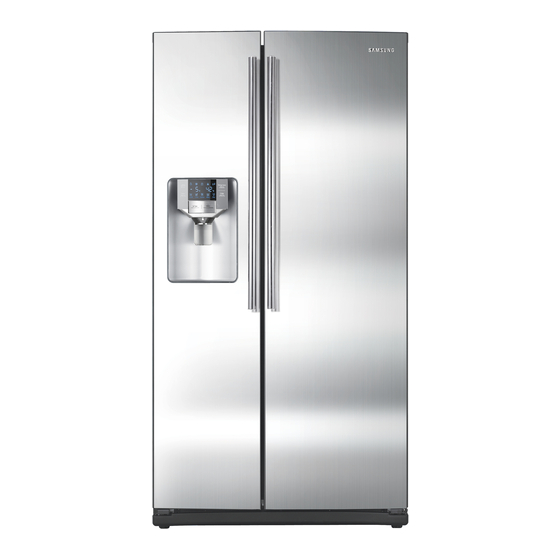
Chapters
Table of Contents
Troubleshooting

Summarization of Contents
Samsung Refrigerator Overview
Product Features
Highlights key features of the refrigerator.
Warning and Safety Notices
Important Safety Notice
Details the service guide's purpose and liability.
Precautions and Safety Warnings
General Safety Guidelines
Lists essential safety points like unplugging, using correct parts, and earthing.
Specific Usage Cautions
Illustrates specific 'Do not' scenarios for user safety.
Product Specifications
Key Refrigerator Features
Explains features like Twin Cooling, Multi-Flow, Xtra Space, etc.
Electrical and Refrigeration Specifications
Details electrical ratings, refrigerant, and component specifications.
Interior Views and Model Comparisons
Shows internal layout diagrams and compares model specifications.
Component, Dimension, and Refrigerant Details
Provides detailed specs for components, dimensions, and refrigerant.
Air Circulation and Optional Materials
Illustrates air circulation and lists optional materials.
Operating Instructions and Installation
Digital Panel and Temperature Control
Explains the digital display operation and temperature settings.
Advanced Functions: Power/Child Lock, Ice/Water, CoolSelect Zone™
Details operation of Power Freeze, Child Lock, Ice/Water dispenser, and CoolSelect Zone™.
Ice Maker Operation and Defrost Function
Explains ice maker preparation, operation, and defrost cycles.
Refrigerator Installation Procedures
Details steps for moving, preparing, and installing the refrigerator, including door removal.
Alignment and Adjustments
Forced Operation and Diagnostic Modes
Explains forced operation modes, sound alerts, and self-diagnosis initiation.
Load Check and Set Point Adjustments
Details load checks, power outage restoration, and temperature set point adjustments.
Disassembly and Reassembly
Door Disassembly and Reassembly
Provides step-by-step guides for removing and reattaching refrigerator and freezer doors.
Refrigerator Component Disassembly
Details disassembly of refrigerator components like panels, drawers, and evaporator.
Freezer Component Disassembly
Details disassembly of freezer components like bins, ice maker, and evaporator.
Machine Compartment Disassembly
Details disassembly of the electric box, condenser fan, and water solenoids.
Troubleshooting
Troubleshooting: Power, Compressor, and Fan Issues
Flowcharts for diagnosing power, compressor, and fan motor problems.
Troubleshooting: Defrost, Self-Diagnosis, and Alarms
Flowcharts for diagnosing defrost, self-diagnosis, and alarm sound issues.
Troubleshooting: PCB, CoolSelect Zone™, and Lamp Issues
Guides for troubleshooting PCB, CoolSelect Zone™, and lamp failures.
Troubleshooting: Ice Dispensing and Solenoid Issues
Flowcharts for diagnosing ice dispensing and solenoid valve problems.
Exploded View and Parts List
Exploded Views of Major Sections
Diagrams showing parts breakdown for freezer, refrigerator, cabinet, and doors.
Block Diagram
System Block Diagram Overview
Illustrates the main components and their interconnections.
Circuit Diagrams
Detailed Circuit Diagrams (Models)
Provides detailed wiring diagrams for specific refrigerator models.
Circuit Descriptions
Description of Key Circuits
Explains source power, oscillator, door sensing, temperature sensing, and other circuits.
Service Safety Instructions
General Safety Precautions and Procedures
Lists essential safety steps before and during repair.
Component and System Checks
Explains how to check wire connectors, relays, sensors, and door switches.
Reference Information
Q&A: Common Refrigerator Issues
Addresses common problems like insufficient cooling, frozen food, noises, and leaks.







Need help?
Do you have a question about the RS267 LASH and is the answer not in the manual?
Questions and answers